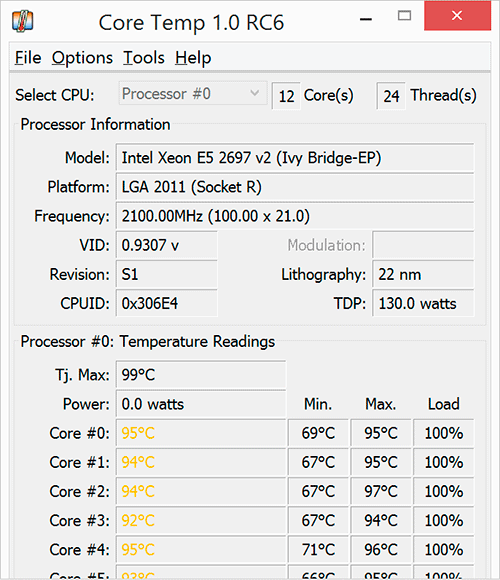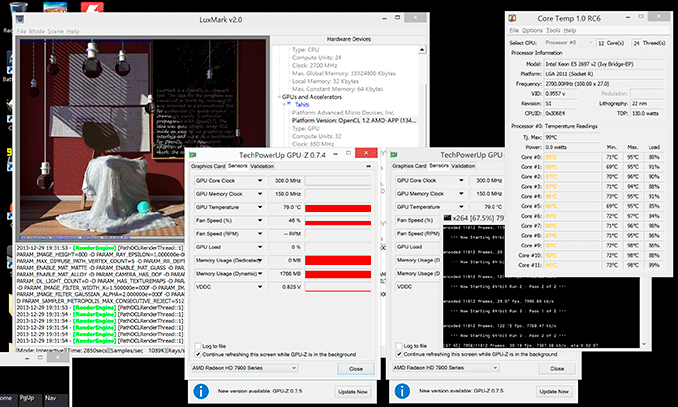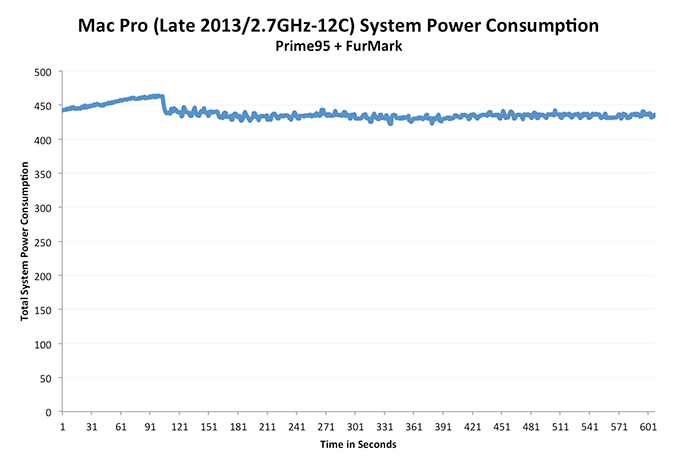The Mac Pro Review (Late 2013)
by Anand Lal Shimpi on December 31, 2013 3:18 PM ESTPower Consumption & Noise
The Mac Pro’s thermal core makes a lot of sense from an area efficiency standpoint as the chances that you have all three processors in the system (Xeon CPU + dual AMD FirePro GPUs) running at max speed at the same time is highly unlikely. By having all three players share one large heatsink Apple can optimize for the most likely usage scenarios where at most one processor is running at close to max TDP. From the moment the system was introduced however I was curious to see if its thermal design could deal with all three processors going full tilt. I decided to test both scenarios out.
The vast majority of the time the Mac Pro’s single fan spins at a paltry 769 RPM. At this speed the Mac Pro is virtually silent. I have a Promise Pegasus R6 Thunderbolt chassis with four 3.5” 7200 RPM hard drives inside. The Pegasus sits four feet away from my Mac Pro and at idle the hum of its drives drowns out the idle fan noise of the Mac.
Even running heavily threaded CPU benchmarks does nothing to impact fan speed. It's not until you run a prolonged workload that you can hear an increase in noise from the Mac Pro. I ran FurMark under OS X in parallel with a relatively heavy 4K render in Final Cut Pro. I was rendering a 20 minute 4K project with two effects applied across the entire timeline. The basic render used up 4 - 8 threads, while the effects ensured the compute GPU had some work to do. FurMark obviously kept the display GPU busy. After around 25% of the rendering task was complete the Mac Pro’s fan smoothly scaled up to 1400 RPM, then 1600 RPM and finally stopping at what I believe is full speed: 1900 RPM.
I crudely measured noise sitting at my desk, approximately 18” away from the Mac Pro at all of these points:
| Mac Pro (Late 2013) Fan Noise vs. RPM | ||||||
| Fan Speed (RPM) | Measured Sound Pressure Level @ 18" | |||||
| Off | 32.2 dBA | |||||
| 770 RPM | 32.4 dBA | |||||
| 890 RPM | 32.8 dBA | |||||
| 1097 RPM | 34.1 dBA | |||||
| 1193 RPM | 35.2 dBA | |||||
| 1440 RPM | 38.6 dBA | |||||
| 1500 RPM | 39.4 dBA | |||||
| 1900 RPM | 44.7 dBA | |||||
System noise isn’t an issue the vast majority of the time. Even if you’re running for short bursts with everything cranking away on a problem. It’s only under prolonged use of the CPU + both GPUs that the fan has to spin up this high. I quit FurMark and kept the FCP render going, which brought system power down from ~380W to ~326W. It also slowly dropped fan speed from 1900 RPM down to 1500 RPM before smoothly alternating between 1200 RPM and 1450 RPM. The way the Mac Pro’s fan ramps is actually just as important as its ability to remove heat. There are no dramatic increases in speed, just an incredibly smooth curve that the Pro’s fan moves up and down.
The system never gets annoyingly loud, it just varies between silent and calmly reminding you that there’s a large fan inside. Even at full bore the Mac Pro’s fan noise is more pleasant than harsh. It’s not magic, just good system design coupled with the fact that even with a pair of D700s Apple went a bit conservative on GPU speed. Had this been a system capable of pulling 800W at the wall, we’d be having a different discussion about noise.
My next task was to see what actually happens in this worst case scenario. If you’re running all of the parts at full tilt, are any of them going to throttle? I have to work pretty hard to get the fan to spin up under OS X, but in Windows it’s a lot easier since I can just toss a single multi-GPU workload at the problem.
I started out by running LuxMark, an OpenCL workload, on both GPUs as well as a multithreaded 7-Zip benchmark on all of the CPU cores. I monitored both CPU and GPU frequencies. The result was no throttling across the board:
Getting an accurate reading on GPU frequencies from Tahiti based GPUs ends up being harder than I expected, but I saw what Ryan reminded me is typical behavior where the GPUs alternate between their 650MHz base clock and 850MHz max turbo. We don’t have good tools to actually measure their behavior in between unfortunately.
The same was true for the CPU. Even with all 12 cores taxed heavily, I never saw any drops below the CPU’s 2.7GHz base clock.
Next I tried a heavier workload on the CPU: a H.264 video encode. Here I just ran the x264 5.01 benchmark in parallel with the LuxMark workload. Once again, I saw no drop in CPU or GPU clocks although I believe I was approaching the limits of where that would hold true. The system was pulling an average of 410W at that point, with peak power draw at 429W.
If you’re wondering, there was little to no impact on the x264 benchmark from having LuxMark run in the background. The first rendering pass took about a 3% hit, likely due to the CPU not being able to turbo as high/at all, but the second heavily threaded pass was on par with my standalone run without LuxMark in the background. LuxMark on the other hand saw around a 14% reduction in performance, from 2040K samples per second down to 1750K when run in parallel with the x264 test. We’re still talking about two extremely compute intensive tasks, the fact that I can run both with little performance reduction is an example of the sort of performance scaling that’s possible if you leverage all of the compute in the Mac Pro.
So far I wasn’t surprised by the platform’s behavior. The Mac Pro’s thermal core and fan was enough to handle a real world workload without throttling. But what about a power virus? For this I ran a combination of FurMark at 2560 x 1440 and Prime95 (in-place large FFTs) across all GPUs and CPU cores.

The GPUs peaked at 97C, which is pretty much as high as a 28nm Tahiti should ever go. The CPU hit a similar temperature, with most cores hovering around 95C. GPU clocks seemed ok, with both GPUs running between 650 - 850MHz (base - boost). The CPU on the other hand dropped down to 2.1GHz (I even saw a short excursion down to 2GHz). Average power while running this workload was 437W, peaking at 463W before CPU throttling kicked in. If you plot out a graph of power vs. time you can see the CPU throttling kick in during the workload.
I have to stress that I haven’t been able to get this to happen in any normal workload, only what’s effectively a power virus for the GPUs and something quite unrealistic for the CPUs. Either way it shows us the upper limit of what the thermal core can do.
Overall power consumption is down considerably compared to previous generation Mac Pros:
| Mac Pro Power Consumption | ||||||
| Idle | Multithreaded CPU Load | |||||
| Apple Mac Pro (Late 2013/2.7GHz-12C) | 85.5W | 190.7W (Cinebench 11.5) | ||||
| Apple Mac Pro (Early 2009/2.93GHz-8C) | 125.3W | 254W (Cinebench R10) | ||||
| Apple PowerMac G5 Dual 2.5GHz | 120.8W | 252.2W (Cinebench R10) | ||||
Idle power consumption is down and power efficiency under load is way better than the early 2009 Mac Pro I have here. As far as I can tell, max power consumption for either compute system (CPU alone or dual GPUs alone) is around 300 - 320W. With both subsystems combined you'll get the 437W figure I talked about earlier.
You don't even need a power virus to get there. Running two realistic workloads that are heavy enough won't get you up to the 463W point where I saw throttling, but it'll get you close to the max average power I recorded on the Mac Pro.















267 Comments
View All Comments
LorneKwe - Friday, January 3, 2014 - link
How about we replace those Quadro 6000's with Radeon 7970s which are what the Mac Pro has inside. You can make any price comparison look like shit when you erroneously drop a few thousand dollars worth of GPUs into the build.Dual 6GB 7970s cost $1,400.
Using that, we can build out a 24C Dual Xeon 2697v2 workstation, with 64GB of RAM, dual 512GB 840 Pro SSDs in RAID0, H100i cooling on each CPU, and it would come to around $10,000. Same price as the Mac Pro's kitted out, 12C config, double the CPU power, and a good chunk more GPU power as they aren't underclocked.
You also have the option of going with 4x 7970s if you chose to, and if you forgo to ASUS Z9PE board for a proper workstation board, you can go up to 512GB of RAM instead of being capped at 64GB. If you want dual Quadro K5000s instead of 7970s, raise the PC's price by around $1600, but understand that these will outperform Apple's D700 pair by an enormous margin.
If you're looking for portability, or absolutely require OS X for what you do; choose the Mac Pro. If you're looking for computer power that won't throttle down when faced with tough workloads; have a full-fledged workstation built for you and get much more bang for your buck.
stingerman - Sunday, January 5, 2014 - link
Sorry Dude, this is a Pro Workstation, that mean workstation class GPUs. 7970 is a great CPU but there is a reason it doesn't go into Workstations...madwolfa - Sunday, January 5, 2014 - link
And what is it? Drivers? D700s in Mac Pro don't even have ECC memory enabled in them.wheelhot - Monday, January 6, 2014 - link
yes, the drivers provided (and I believe you can only test this in Windows?) will determine if it's actual workstation class GPUs or just Radeons with the name FirePro slapped on it. I'm seriously hoping it's supplied with actual workstation GPU driver, as it'll greatly benefit the software I use.LorneKwe - Tuesday, January 7, 2014 - link
I'd agree with you if we didn't have solid evidence that Apple's D700 is a repurposed 7970; lack of ECC memory being the best clue, and pricing being a great clue as well.scarhead - Saturday, January 4, 2014 - link
One Xeon E5-2697 processor costs $2,614. Two costs $5,228. I doubt your $3,712 figure for complete system is accurate.p51mustang6 - Thursday, January 2, 2014 - link
Apparently any comment disagreeing with the author gets deleted.chaos215bar2 - Friday, January 3, 2014 - link
Clearly not. Perhaps your comment was rude, trolling, and / or being argumentative without actually adding anything to the discussion?Johan Niklasson - Friday, January 3, 2014 - link
Great review - thanks. I just wanted to add that the new Mac Pro design and its finish does matter more than most people understand. The ones who work on graphic and video applications usually are artists with some sense of beauty and aesthetics. I am sure that the much more pleasant looking Mac Pro is a welcome addition to such people's workspaces.Also the smaller form factor and the silence will make it hard to resist!
james-bond - Friday, January 3, 2014 - link
Thanks for the great review. I wonder if some of the USB ports should have been on the other side of the chassis. Seems like the power cord and monitors are things that are rarely unplugged and are usually on the back side of current case designs. Having to reach around to plug and unplug a flash drive seems inconvenient.Please keep and eye out for an upgrade to Logic Pro (Apple's audio pro app). A would love for you to benchmark this in the same way you did Final Cut. I doubt Apple will be able to harness the second GPU for compute in audio applications do to latency in doing real time audio monitoring. Audio has taken a back seat to video apps in this version of the Mac Pro it seems.